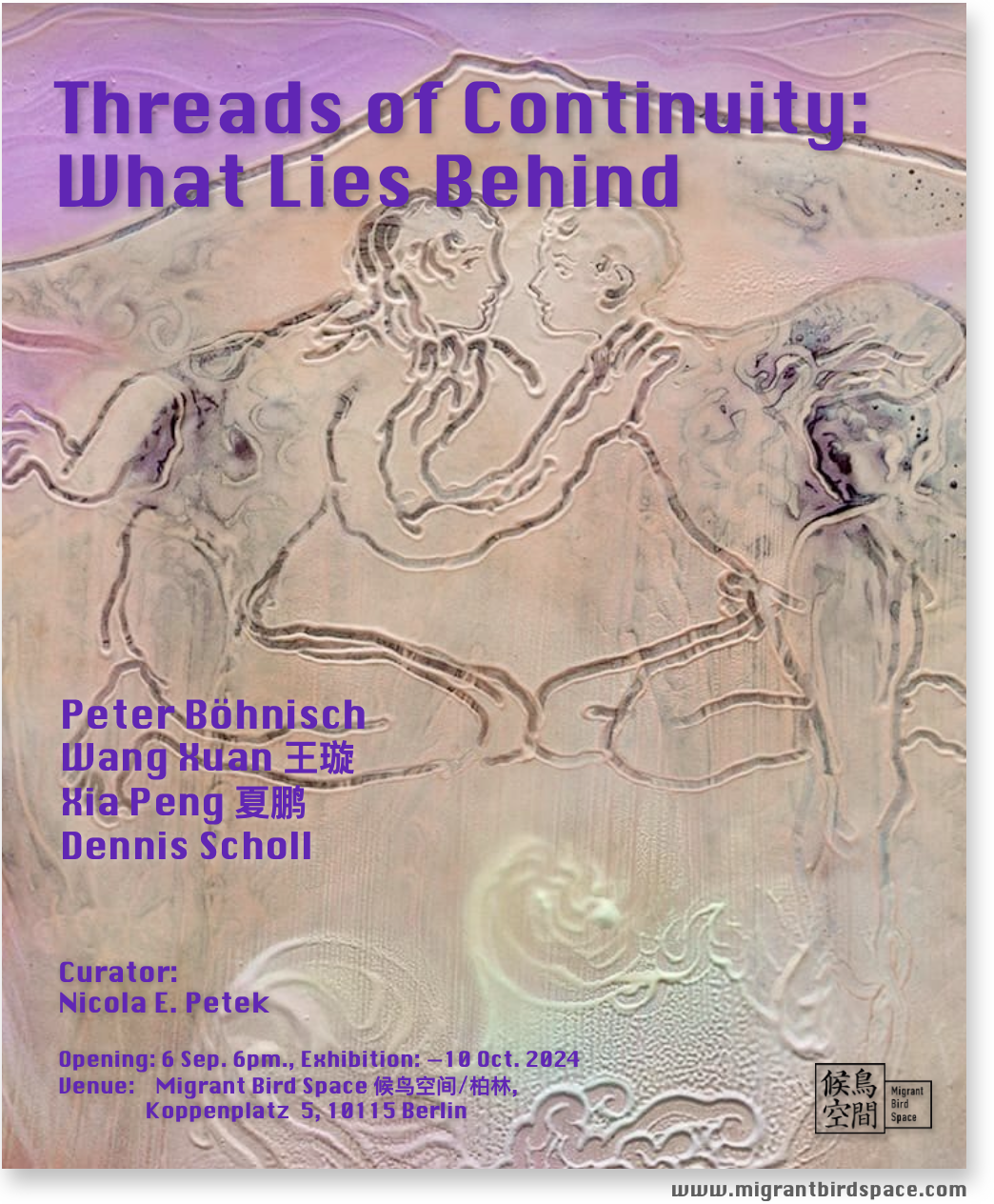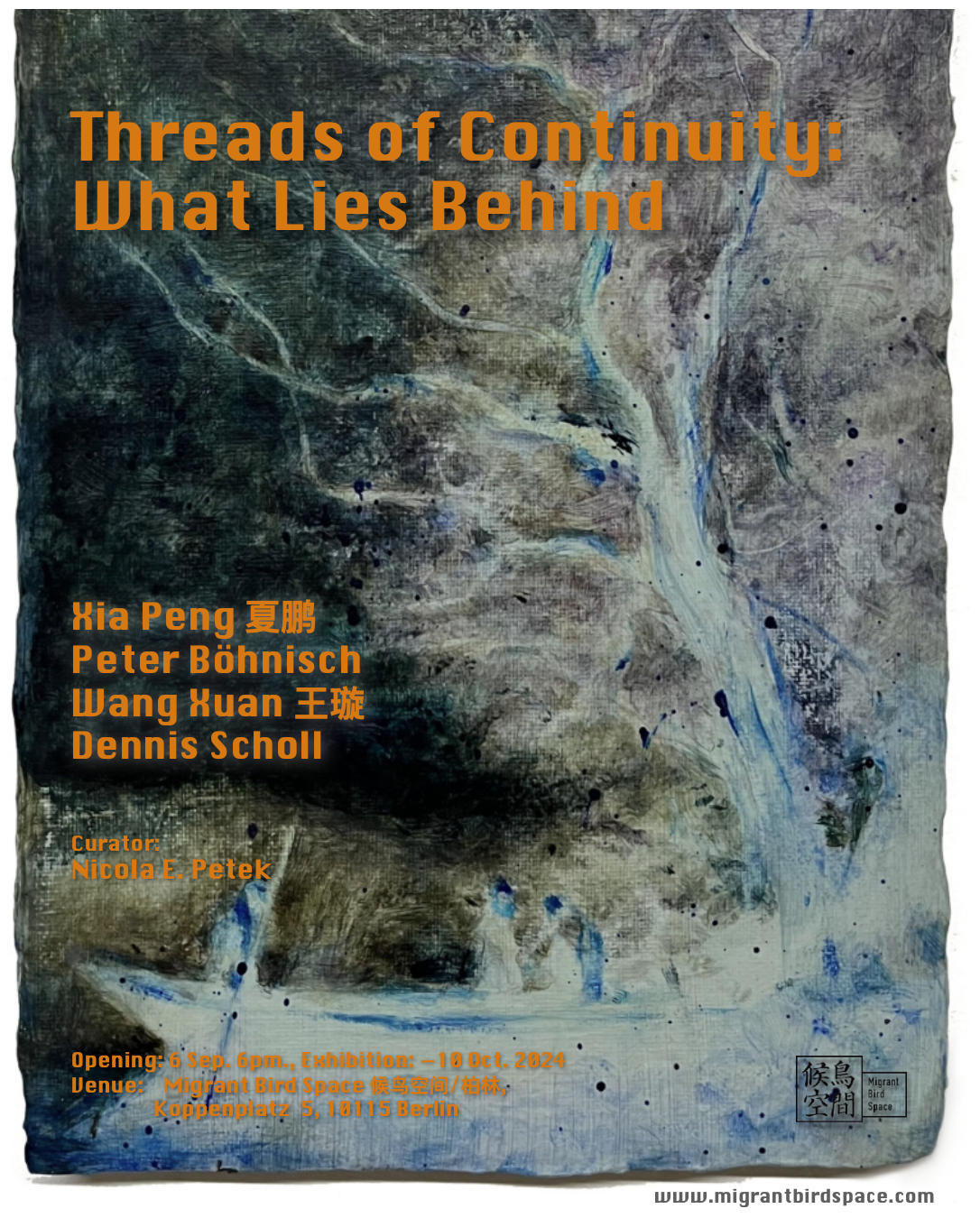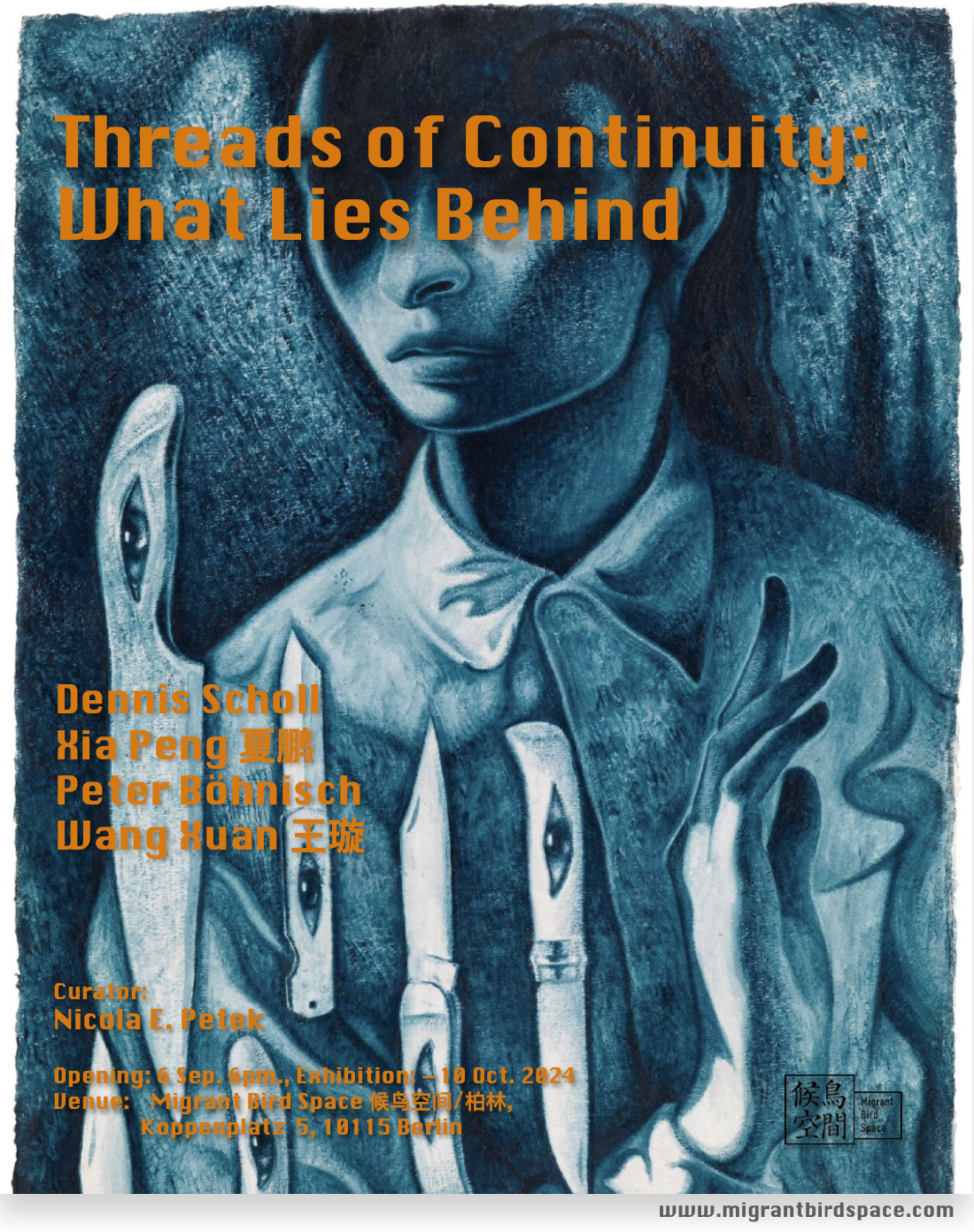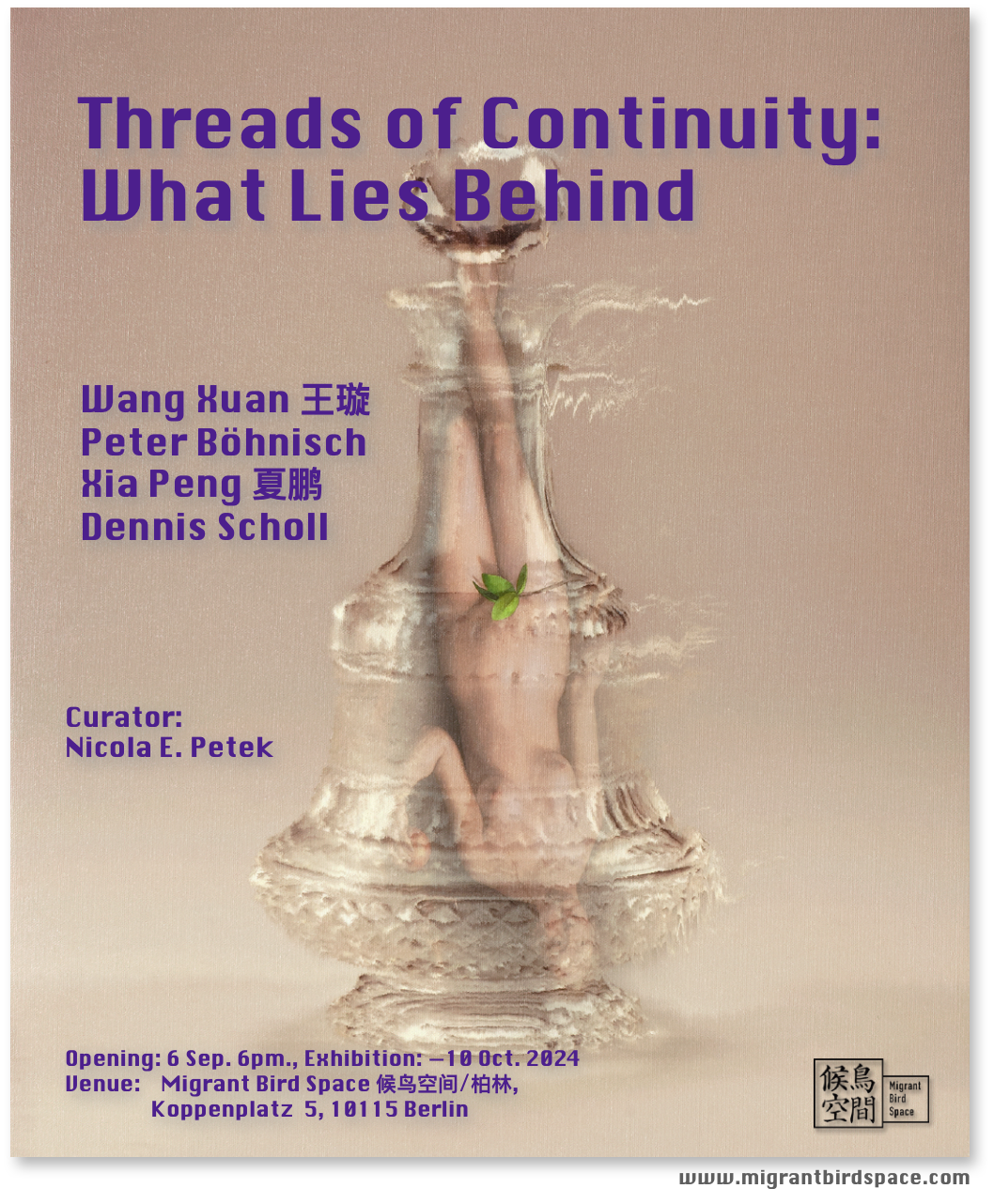Artists: Peter Böhnisch, Xia Peng, Dennis Scholl, Wang Xuen
Curator: Nicola E. Petek
Opening: 6 September 2024
Threads of Continuity: What Lies Behind
This exhibition brings together the works of four contemporary artists—Peter Böhnisch, Xia Peng, Dennis Scholl, and Wang Xuen, and—each of whom offers a unique perspective rooted in their diverse experiences. Yet, they are united by a common thread:
the exploration of identity, memory, and the intersection of tradition with modernity.
The exhibition is not just about the visible aspects of the artworks but delves into the invisible—revealing the emotions, thoughts, and sensations the artists experienced during the creative process. Thus “Threads of Continuity: What Lies Behind" creates a dialogue between these artists' works, illustrating how different cultural contexts shape their artistic expressions while highlighting universal themes that transcend geographical and cultural
boundaries.
Their poetic forms of painting evoke emotions, tell stories, and invite reflection. The title, "What Lies Behind," refers to the hidden dimension of artistic creation—the emotional and mental processes that unfold during painting. This exhibition emphasizes that art is more than what meets the eye; it is an expression of inner worlds that only become visible through deeper engagement.
By presenting works that delve into emotional depth and the intricacies of inner worlds, "Threads of Continuity: What Lies Behind" encourages viewers to consider how history, tradition, and contemporary life intertwine in the formation of individual and collectiveidentities. The exhibition offers a unique opportunity to explore these invisible dimensions,inviting reflection on the complex tapestry of human experience and the continuity of cultural narratives across time and space.
Peter Böhnisch
Peter Böhnisch is a German artist whose work delicately intertwines themes of nature, memory, and poetry, creating a contemplative and evocative body of art. Born in 1977, Böhnisch has developed a distinctive style that merges drawing, painting, and collage, often using these mediums to explore the intricate relationships between the natural world and human experience. His work is marked by a sensitivity to the subtleties of form and texture, with an emphasis on the emotional resonance of his subjects.
Nature plays a central role in Böhnisch's art, not just as a backdrop, but as a living, breathing entity that interacts with the human figures and abstract elements in his compositions. His depictions of flora, fauna, and landscapes are infused with a sense of reverence and wonder, capturing the fleeting beauty and fragility of the natural world.
Böhnisch often uses organic shapes and flowing lines to convey the rhythms of nature, creating visual poetry that reflects his deep connection to the environment. Memory seems to be another key theme in Böhnisch's work, serving as a bridge between past and present, the personal and the universal. His art often evokes a sense of nostalgia, as if capturing moments suspended in time, layered with the emotions and experiences that have shaped them. This exploration of memory is not linear but fluid, much like the natural forms he depicts, suggesting the ever-changing and elusive nature of our recollections.
Poetry, both in the literal and metaphorical sense, is integral to Böhnisch's creative process. His work can be seen as a visual form of poetry, where each line, shape, and color is carefully chosen to evoke a specific mood or atmosphere. The poetic quality of his art lies in its ability to convey complex emotions and ideas through minimalist, sometimes abstract compositions. Böhnisch's use of space, light, and shadow adds a lyrical dimension to his work, inviting viewers to engage with it on a deeper, more introspective
level.Peter Böhnisch's ability to blend his themes into harmonious compositions has earned him recognition as a significant figure in contemporary German art, with a body of work that resonates with viewers on both an emotional and intellectual level. Through his art, Böhnisch invites us to reflect on the beauty and transience of life, and the enduring power of memory and nature in shaping our inner worlds.

Xia Peng
Xia Peng is a contemporary Chinese artist whose work bridges the rich traditions of Chinese art with the innovative currents of Western contemporary art. His paintings are characterized by a unique interplay between complexity and simplicity, where seemingly chaotic elements are harmonized into a cohesive whole. This delicate balance is rooted in the Chinese artistic principle of finding clarity and simplicity within complexity, a concept that Xia Peng masterfully explores in his work.
His artistic journey reflects a deep engagement with both abstract and concrete forms. Xia Peng's paintings often hover between these two realms, creating a dynamic tension that invites viewers to explore the spaces in between. From 2015 to 2021, Xia Peng underwent a significant evolution in his artistic approach. He began to distance himself from a subjective viewpoint, instead focusing on the subtle interactions between time and space, and how these dimensions can be expressed through nuanced tones and quiet compositions. His recent works have moved toward a more abstract aesthetic, where traditional narratives dissolve into minimalist forms, often rendered in monochromatic palettes. This progression reflects Xia Peng’s ongoing exploration of the boundaries of visual art, as he seeks to create images free from conventional structure, yet resonate with a profound sense of harmony and infinite possibility.
Xia Peng's art is a meditation on the balance between order and chaos, narrative and abstraction, structure and freedom. His work challenges viewers to look beyond the surface, to find meaning in the spaces that are not immediately apparent, and to appreciate the subtle, often understated beauty that lies within.

Dennis Scholl
Scholl paints and draws pictures full of tenderness and compassion. It is immediately apparent that he cares a great deal about his protagonists. His working process resembles caring, affection, and empathy. Those who rise up out of the ground in the painting become his counterparts. It almost seems as if they are participating in the scenes being created, taking the brush out of the painter's hand. His world develops and becomes more
complex with each new depiction, it has been growing in Scholl's studio for years, is constantly taking shape, and is full of warmth. However, it also repeatedly contains moments of heightened danger and violence. Possibly to find safety, the protagonists shown repeatedly perform rituals and are rarely inactive. The artist often draws on themes, symbols, and figures from religious pictorial traditions. The images move through an idiosyncratic space in which a multitude of protagonists meet. In the twilight of the morning sun or early evening, partially protected from prying eyes by dense foliage, the figures indulge in their actions and inclinations. Scholl sensitively and delicately explores the psyche of his protagonists.The narrative character of his work and the way in which he executes his paintings and drawings are reminiscent of art-historical role models such as Balthus - particularly with regard to some of the enraptured, dream-like scenes. Artists such as Hendrick Goltzius, Alberto Savinio and André Masson, Pierre Bonnard and Balthus' brother Pierre Kłossowski are also influential. Scholl also makes reference to literary and philosophical figures. The psychoanalyst Jacques Lacan, the philosopher Georges Bataille and the poet Rainer Maria Rilke are just as important as the Baroque as an epoch.

Wang Xuan
Wang Xuan, born in 1979 in Guangxi Province, China, is a distinguished contemporary painter known for his evocative and innovative approach to art. Growing up in a region renowned for its natural beauty and cultural heritage, Wang Xuan's early exposure to the landscapes and traditional arts of Guangxi seems to have deeply influenced his artistic vision. Over the years, he has developed a unique style that seamlessly blends traditional
Chinese painting techniques with modern sensibilities, creating works that are both reflective and forward-looking.
Wang Xuan’s paintings often explore the interplay between the natural world and human experience, capturing the transient beauty of landscapes while infusing them with a sense of personal and collective memory. Through his use of color, form, and texture, Wang Xuan creates compositions that are at once delicate and powerful, inviting viewers to immerse themselves in the emotional and spiritual depth of his work.
As a contemporary artist, Wang Xuan has exhibited his work both in China and internationally, gaining recognition for his ability to transcend cultural boundaries while staying rooted in his heritage. His work reflects a deep understanding of traditional Chinese aesthetics, yet it is imbued with a modern sensibility that resonates with a global audience. Wang Xuan continues to push the boundaries of contemporary Chinese art, making him a prominent figure in the ongoing dialogue between tradition and innovation in the art world.

